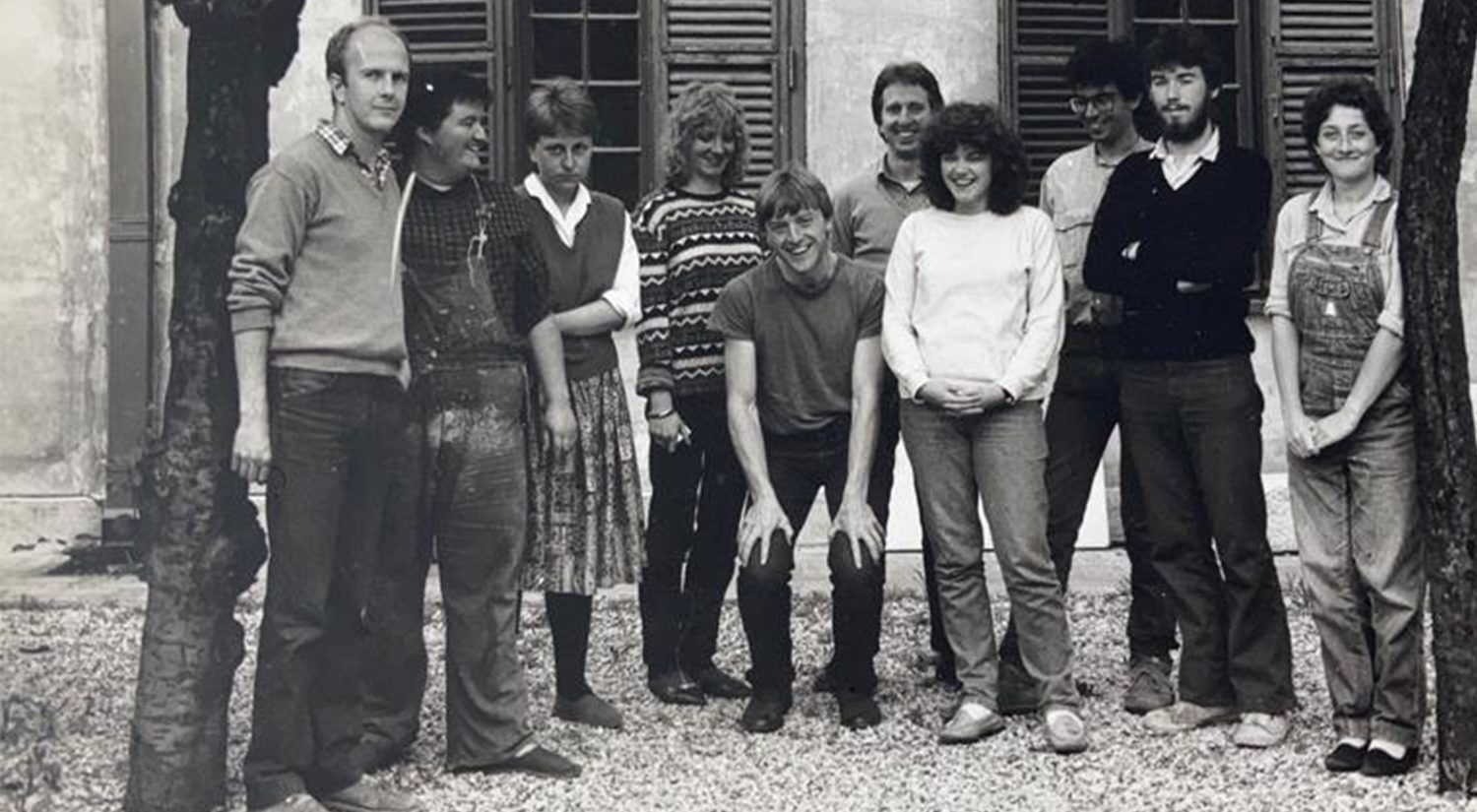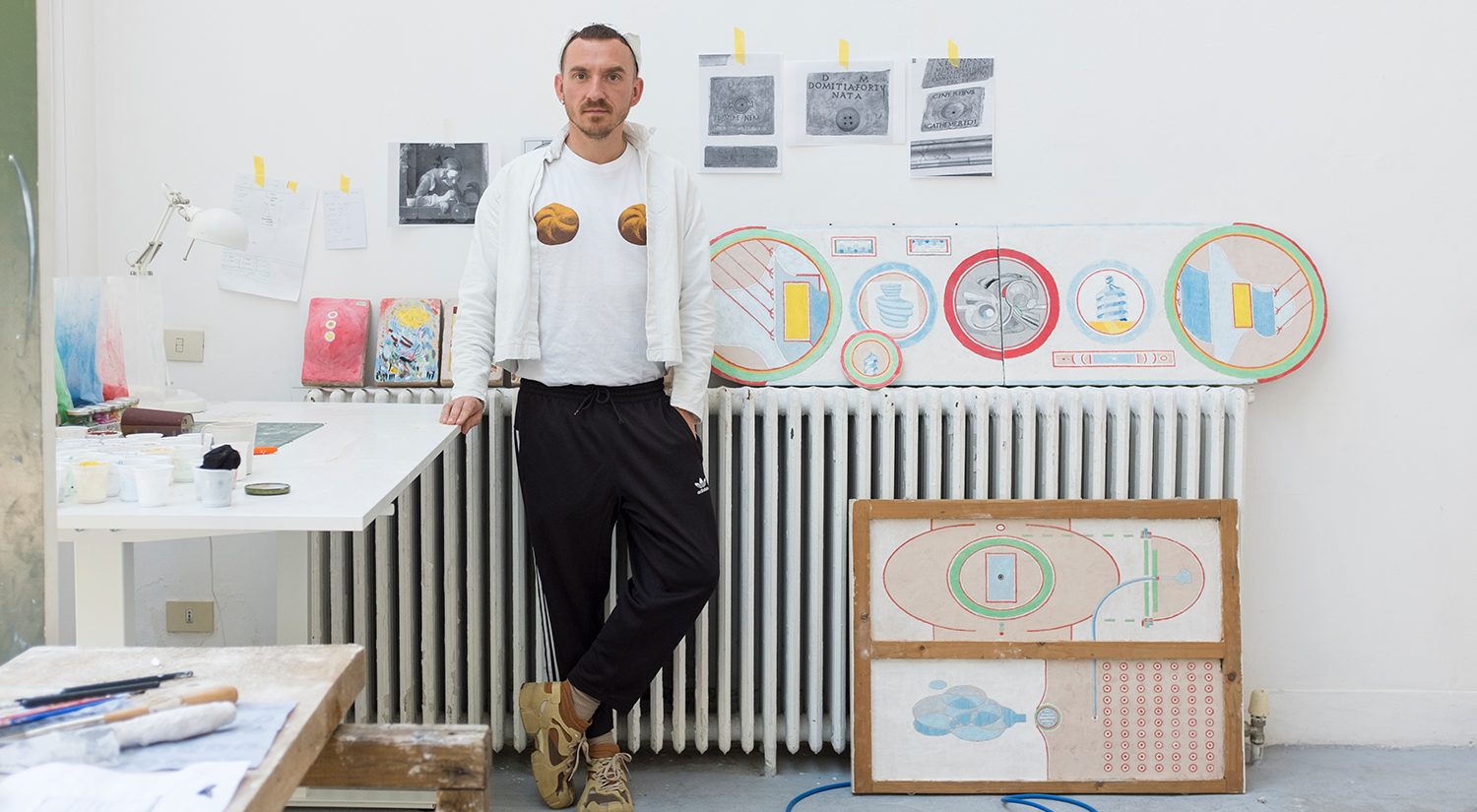An interview with Claudio Pestana, Abbey Scholar in Painting September 2021–June 2022, in which they speak about the works they have produced during their residency at the BSR so far.
1. Your practice explores themes of identity and history, amongst other concepts. How are you developing these themes within the framework of your project at the BSR where you are examining the Grand Tour landscape through a Queer lens?
My current project ‘Fag Goes on Tour’ is a natural development from my most recent series, ‘Fag Attacks the Country’ (2020-21) and ‘Fag Has an Audience’ (2021) – where I Queered the tradition of landscape and portraiture painting with a series of self-portraits in which I invaded the English rural landscape and the grand houses of the landed gentry.
So how did I get to Rome? Well, when I thought of applying for the Abbey Scholarship in Painting with a residency at the British School at Rome (BSR) what first came to my mind was that I wanted the idea for a project to emerge from the identity of the award and its international roots. As such, I wanted to find a connection between Rome and London across time and space: history, city, and travel. By chance, at the time of the application I had talked to a friend about the figure of William Beckford, who has been with me since I first read his evocative gothic novel ‘Vathek’ as a teenager, and I discovered that Beckford had travelled to Italy in 1780 as part of his Grand Tour of Europe. A fortuitous encounter with one of his travel notes, drew me further to Rome:
“THEY say the air is worse this year at Rome than ever, and that it would be madness to go thither during its malign influence.” William Beckford, Letter XVI, Italy, 22nd October 1780.
From there I set out to research the history of the Grand Tour, with all its associated connotations, and to juxtapose it with the present. I must note that whilst wanting to critically engage with and de-construct the phenomenon of the Grand Tour, I became aware how during its existence the Grand Tour was a sort of independent wandering academy, without which today there would be no BSR or other such academies. Archaeology, architecture, curating and museology, and visual arts owe their standing to the Grand Tour (with warts and all).
As I researched the archives of the BSR I encountered and was inspired by the prints of De’ Rossi, Dubourg, Duflos, Falda, Labruzzi, and of course Piranesi. As I visited galleries, museums, and palaces in Rome and beyond, I looked at the works of the Grand Tour era by the vedutisti, such as van Wittel, and the portrait painters, such as the star of the time Pompeo Batoni (hardest to find in Italian collections – I resigned myself to viewing Batoni’s “tourist” portraits in British collections).

As I examined the social context of the Grand Tour (e.g., see Rosemary Sweet, 2012), one of the many things that struck me was how the Grand Tour contributed to the construction and performance of masculinity. At some point in time, British critics of foreign travel argued that travelling (particularly to France and Italy) compromised masculinity and promoted habits of effeminacy. To me this was another connection to one other recurrent core theme in my practice, identity – and specifically my Queer identity.

So all of these works and travel and research experiences then started emerging and converging into different layers of my work to give birth to a self-portrait combined with a ‘capriccio’ interpretation of some of the things I have seen and experienced so far during my “tour of Italy”. As such, it would be fitting to say that whilst at the BSR these concepts have developed and crystallised into a Queer Italian capriccio.

2. You have said that life is performative. Can you say something about the impact of having the BSR and Rome as your stage?
Performativity (beyond the concept’s initial conceptualisation as linguistic in nature) is a core concept in my practice. It has always been (as I believe life is inherently performative), but looking back at my previous work, until more recently performativity was present as an intuitive unconscious gesture and I was less critically aware of how crucial it was to my work. I see performativity in all actions, including art making, but I find it important to distinguish between performative acts that are unconscious from those that are conscious and intentional. The fact is that most actions are unconsciously performative – otherwise one would be paralysed in life, constantly questioning one’s actions and intentions. In my practice I now engage with performativity in a more consciously intentional way, but I still accept that a lot of the gestures in my work are unconscious and I embrace them as being as valid as those that I plan in advance.
As performativity became more present in my mind, I started becoming more aware of how tourists perform their roles when they pose for the camera, and how there is a gender difference in how many women accentuate their femininity and men assert their masculinity. It has been the case since the beginning of travel; men and women have been depicted and have depicted themselves differently, first in writing, drawing and painting, and now also in photography – Hail the selfie. So my work whilst at the BSR is also examining how travelling has historically been performed, from the Grand Tour letters, travel notes, and portrait paintings that would be read and seen back home, to their modern equivalents, from postcards (becoming rarer) to social media posts full of selfies.
Having the BSR and Rome as my stage means that I have access to experiences and “material” that have inspired me and have emerged in my work. In my painting I pose provocatively in front of the Roman Forum and other Italian landmarks as a way of challenging the ideas of masculinity and femininity that are performed in tourist photos. But most importantly, I am aware that performativity is mediated by context, distribution of power, agency, and social roles. So being at the BSR, being a “tourist” in Rome, I am aware that I perform a certain social role, with a degree of power and social mobility that is denied to many Romans who live in the periphery. So whilst I am Queering the performativity of travel, reminiscing on the Grand Tour, I want to acknowledge this aspect of my trip and of being at the BSR. The “stage” in Rome that I occupy is shared with a diverse multitude of existences most often unseen. They might not feature prominently in the work that I am showing, as this work is focusing primarily on a different social aspect, but they are still there. And there is a very different type of travel in the form of forced migration that also needs to be acknowledged.
Another layer of performativity present in my work is related to being an artist and art making. As all life is performative, I perform being myself in the act of working in the studio at the BSR, in this case, painting. I perform both being an artist and painting the artist – who is present in the painting. I video the performative act as a record of that moment in time. Another way in which the BSR has impacted on the performative aspect of my work has been how I have responded to the grandiosity of the building itself, which has led me to use the gallery space to emulate a Grand Tour musical soirée.











